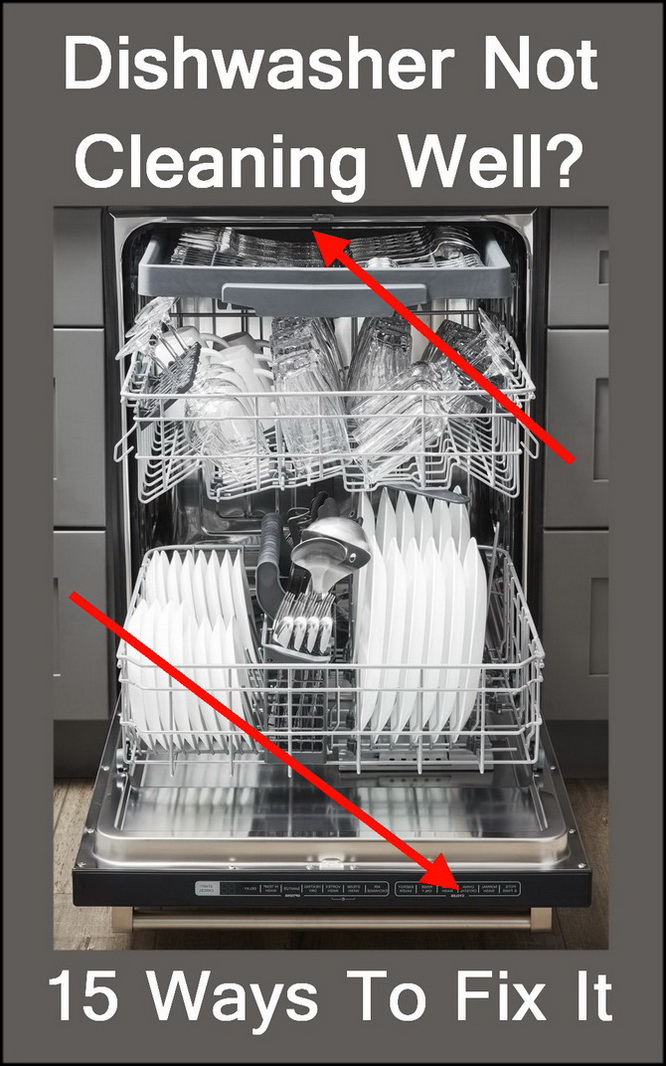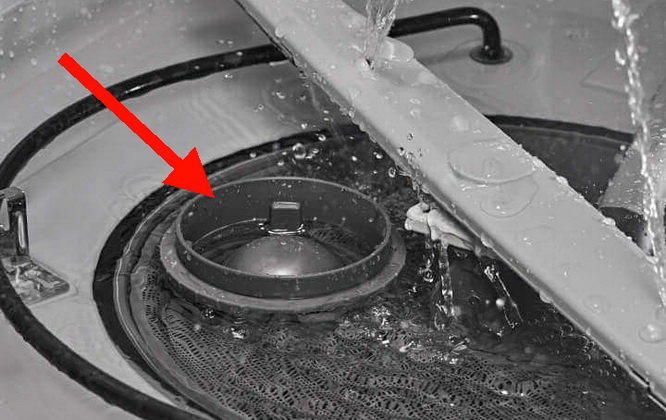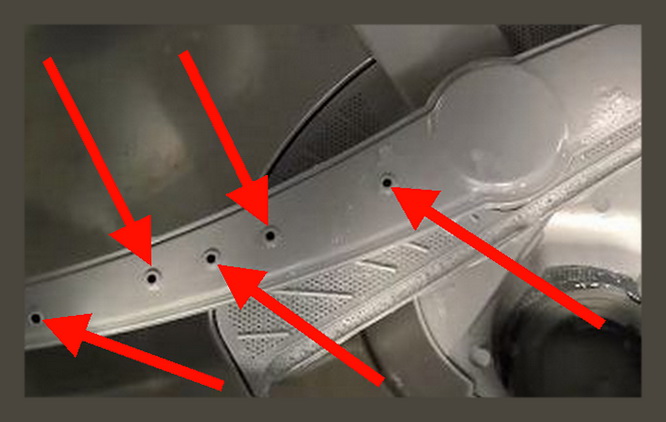Is your dishwasher not cleaning dishes the way it used to? You may have tried multiple solutions but the dishwasher is not cleaning dishes properly. “Why is the dishwasher not cleaning?” Whether you wonder why the glasses come out cloudy or your dishwasher will not clean stains on your plates, the problem is that your dishwasher isn’t cleaning well. We will provide 15 solutions that will help you fix the problem.
 Dishwasher Not Cleaning Well? 15 Ways To Fix It
Dishwasher Not Cleaning Well? 15 Ways To Fix It
Dishwasher not cleaning well – Quick troubleshooting
Before we get into more detailed solutions, there are a few broad troubleshooting procedures you may try. These techniques might help you solve the problem and get your dishwasher working effectively again.
- Check to see if your dishwasher is level. If it is not, the water may not flow properly, resulting in poor cleaning results.
- Inspect that nothing is blocking the spray arms from spinning. If the arms are blocked, the dishwasher will not clean properly.
- Take a look at the filters in your dishwasher. Make sure they’re clean and free of debris. A dirty filter can cause cleaning problems. If the filter is clogged or blocked, your dishwasher won’t be able to properly clean.
1. Make sure that your dishwasher is level
If your dishwasher is not level, the water may be on only one side and your dishes will not come out clean. To fix this, simply check to see if your dishwasher is level and adjust it accordingly. Use a level on top of the dishwasher to be sure it is fully level to the floor.
2. Remove any large items from the dishwasher
If there are large items or obstructions in your dishwasher, it will be difficult for the machine to clean everything effectively. Make sure to remove any large items that could be blocking the spray arms before running a cycle. If the spray arms are obstructed, they will not be able to rotate properly and will not clean the dishes, cups, or utensils effectively.
3. Check the filter inside of your dishwasher
Your dishwasher filter assists to keep the machine clean. If the filter becomes clogged, the dishwasher’s ability to fully clean will be reduced. Make sure you inspect the filter regularly and clean them as needed. The dishwasher filter is located in the bottom of the dishwasher on the inside. Remove the dishwasher filter and run it under hot water to clean it. Check the water filter assembly (where the water filter fits into the dishwasher) in the dishwasher to be sure there is nothing inside that may be blocking water flow. Remove any soap scum, mold, hard water, light mineral buildup, or food deposits if found.
 Dirty dishwasher filter causes dishes not clean
Dirty dishwasher filter causes dishes not clean
4. The dishwasher wash cycle is not long enough
If the cycle time of your dishwasher is too short, it may not have enough time to clean all of the dishes. Try running your dishwasher on a longer wash cycle to see if that helps. There may be options on your dishwasher to run longer by increasing the time or switching to a more powerful wash cycle. Refer to your dishwasher owner’s manual if needed.
5. The dishwasher needs to be descaled
If your dishwasher isn’t cleaning properly, it may be time to descale it. A dishwasher’s calcium or lime deposits may need to be removed via descaling. You run a white vinegar cycle to help remove any hard water that may exist inside the dishwasher. You can also use a special dishwasher descaling product to remove the lime and hard water deposits. If you have an older dishwasher and it has never been descaled, this should be done to be sure this is not causing the problem.
6. Check the water temperature
If your dishwasher isn’t cleaning effectively, make sure the water temperature is correct. Dishwashers should be operated at a water temperature of between 120 and 140 degrees Fahrenheit. If the water temperature is too cold, it will not be able to clean the dishes effectively. Try setting the dishwasher on a hotter water temperature to see if this fixes the issue. If the water temperature cannot be controlled using the dishwasher, you can try adjusting the hot water heater in your home to a few degrees higher. Use caution doing this as it will raise the water temperature in your complete home or apartment.
7. Soap dispenser detergent not dissolving properly
If you’re using a powder or gel dishwasher soap detergent, be sure it is fully dissolving during the full wash cycle. Check inside the soap dispenser to be sure the dishwasher detergent has fully dissolved. If the detergent does not dissolve all the way, it will not be effective in cleaning your dishes. As a test, add a small amount of your dishwasher’s detergent into a cup of hot water and stir it until dissolved. If the detergent does not completely dissolve, try adding less detergent, making the water hotter, or switching to a completely different powder detergent. While checking the soap dispenser, check the rinse aid compartment to make sure it is full. Cloudy glasses usually mean low on rinse aid or rinse agent.
8. Inside of dishwasher is dirty
Check for food particles on the inside of the dishwasher. Chunks of food deposits, grease, food scraps, mineral build-up, contaminated water at the bottom, pieces of glass, or broken plates or cups can cause dirty dishes. Try removing any mineral or hard water buildup on the inside of the dishwasher tub by scraping with a plastic putty knife. Cleaning the inside of the dishwasher is vital to making sure the dishes come out clean. Broken glass can clog up the bottom of the dishwasher and the water cannot flow out as needed. This causes dirty water to be tossed around in the dishwasher and plates or cups will not be clean.
9. The dishwasher has low water pressure
If the water pressure in your home is low, it will affect how well your dishwasher is cleaning dishes. To test the water pressure, turn on a faucet in your house and note the PSI (pounds per square inch). If the pressure is less than 20 psi, you may need to raise the water pressure or add a boost pump. If you have a water softener, check to be sure it is not the cause of the low water pressure.
10. Dishwasher spray arms are clogged
Clogged spray arm. The spray arms in your dishwasher may be dirty or clogged from hard water or food debris. This can prevent the water from coming out of the tiny holes and reaching all of the dishes inside. This will cause the dishes, plates, or cups to not be fully clean. Inspect the spray arms in the dishwasher or remove the spray arm and clean it with a soft brush or a toothpick to unblock the small holes. You can remove them and soak spray arms in white vinegar if there is heavy mineral buildup. Be sure to also check for food particles or other debris caught in between the arms. When the dishwasher spray arms are clean and moving properly, the dishwasher will clean your dishes and work properly.
 Dishwasher spray arms have clogged holes
Dishwasher spray arms have clogged holes
11. The top rack not getting clean
There is also an upper spray arm in the top rack of the dishwasher. This arm sprays water onto the dishes in the top rack. If this arm is dirty or clogged, it won’t be able to properly clean the dishes. Check the spray arm for any food debris or blockages and clean as needed. Use a brush and some white vinegar to clean any hard water from the holes. Be sure there are no large objects in the top rack that may be blocking the top rack spray arm. Remove these items if you hear a knocking sound or you can see a plate or cup that may be creating an upper spray arm jam at the top of the dishwasher.
12. Dishwasher overloaded
Your dishwasher may have been overloaded with dishes. When there are too many dishes in the way, the water can’t reach all of them and they won’t come out as clean. Try to evenly space out your dishes so that the water can reach all of them. You may also want to run your dishwasher with fewer dishes in it.
13. Drain hose clogged
If your dishwasher is not draining properly the cause could be the drain hose. Water will stagnate at the bottom of the dishwasher and your dishes will not come out clean. Make sure the drain hose is clear and free of debris. If it’s clogged, the water won’t be able to properly drain from your dishwasher. Remove the dishwasher drain hose and remove debris. Also, be sure the drain hose is not bent or crimped and not letting the water drain out. This drain hose is located under the kitchen sink.
14. Faulty water inlet valve
The water inlet valve supplies water to your dishwasher. If the inlet valve is clogged or you have a faulty inlet valve, the water won’t be able to properly enter your dishwasher and will cause your dishes to come out dirty. The water inlet valve is part of the water line coming into your dishwasher. Make sure that the water inlet valve is clear and free of debris. Check the water inlet valve with a multi meter if needed. Consult the dishwasher owner’s manual if needed to replace the water inlet valve.
15. Faulty circulation or drain pump
The circulation pump, located at the bottom of the dishwasher, is in charge of transporting water through it. If your dishwasher isn’t cleaning properly, your dishes won’t be adequately washed. Check the circulation pump to ensure that it is operating correctly. Check the dishwasher owner’s manual if needed to remove and replace the dishwasher pump.
Dishwasher cleaning hints: To clean and remove scaling, run the dishwasher with vinegar. You can also descale your dishwasher by utilizing white vinegar regularly. Have you tried running your dishwasher with vinegar?
Let us know if you find any other solutions to this dishwasher cleaning problem, and we’ll add them to this page as soon as possible. We hope one of these fixing methods works for you so that your dishwasher can start cleaning plates like new again.
Dishwasher still not cleaning well? It may be time to call a professional if after following these suggestions your dishwasher still isn’t cleaning properly. A dishwasher is a complex dishwashing machine that may require expert assistance to function correctly again especially if the dishwasher is an older model.
Do you need help with a dishwasher not cleaning dishes? Want to Do It Yourself? Let us know your dishwasher problem in the comments below and we can assist you. Please tell us the model number of the dishwasher and we can give you the exact troubleshooting information for your particular dishwasher model.



Leave a Reply